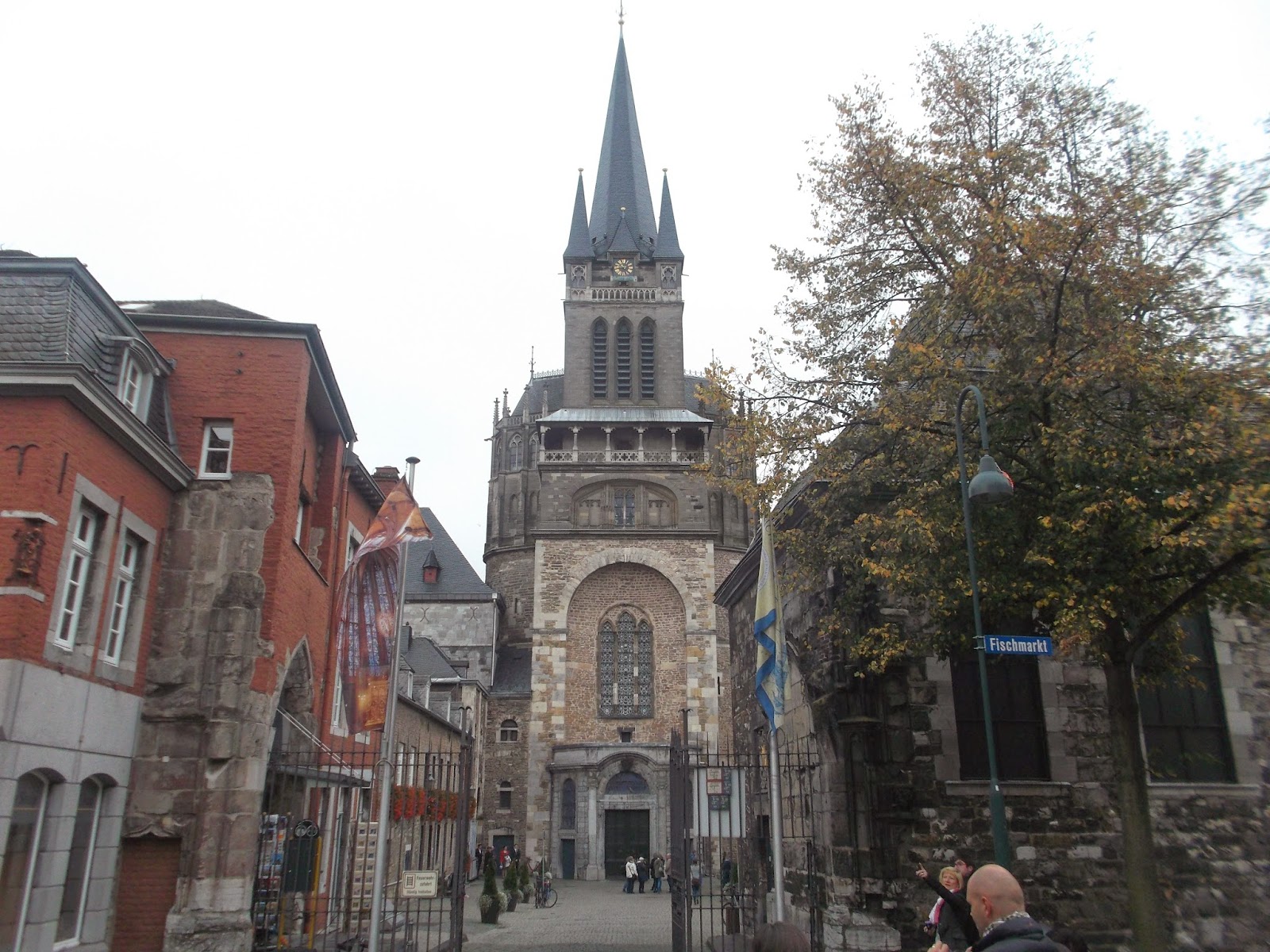Aquisgrana, Aquisgrán, Aix-la-Chapelle, Aachen, a city that has many names and a long history. It was my inspiration for starting this blog about underrated cities. Aachen was the chosen city of Charlemagne to expand his European Empire, making the city the second historical "capital of Europe" (after Rome) and the place of coronation of 31 German Kings. The city is located close to Maastricht (Netherlands) and Liège (Belgium) in an area called Meuse-Rhine Euroregio.
Charlemagne built his palace in Aachen and filled it with treasures. Although the palace no longer exists, its former chapel became Aachen's Cathedral. During the middle ages, the most important treasures were relics that belonged to Jesus, his disciples or his family. Well, believe it or not, Aachen has
Jesus'diapers , Jesus'underwear (loincloth), Virgin Mary's dress and the blanket used to hold John's head. How these items came there, it is a mystery for me. These sacred objects are under custody inside the Cathedral and are only displayed in a ceremony that takes place every seven years. You could also find a fragment of Peter's chain that was used to hold him in Rome, a piece of the sponge used for giving water to Jesus, many Saint's bones and body parts (yuppie!). Charlemagne's remains are in a golden sarcophagus also inside the Cathedral. Most of the Cathedral's treasure is displayed in a separate building and it is one of the largest of the Christendom. The church was built in a byzantine style and it is a Unesco World Heritage.
 |
| This is a "romantic" representation of Charlemagne (according to the audio guide, Charlemagne did not look like that) |
 |
| Cathedral's interior. Observe the byzantine mosaics of the arcs |
In addition to the Cathedral's treasury, Aachen has two art Museums (Suermondt-Ludwig Museum, Ludwig Forum), the Couven Museum (an old mansion transformed into a museum) and the International News Paper Museum. You can also visit the Town Hall that was formerly part of the Charlemagne's palace. My favorite museum is the Ludwig Forum. This institution is located in a former factory built in a Bauhaus style and it has an amazing art collection from the twentieth century. Recently I realized t that the museum is linked with the Ludwig Museum in Cologne. The Ludwig Forum has three floors although the last two are closed (apparently for renovations). Nevertheless, the lions's share is in the first floor and the basement.
The Ludwig has an incredible collection of Pop Art, (Roy Liechtenstein), graffiti art from the New York of the 80's, well-known names as Ai Weiwei among others. The collection is huge and changes every season. Some of the art in the Ludwig is intended to shock the visitor, thus consider you warned. Surprisingly, this museum is usually empty (although the last time I visit the Ludwig there were more than 10 people). The reason is simple, it is located outside Aachen's downtown (20 minutes walk) and honestly it is not well advertised by the tourism office. For those of you who like modern art, this is a mandatory stop. The museum has also a large video collection. One of my favorites is Susan Pitt's Asparagus (1978), a kind of psychological film with plenty sexual symbolism. The film is projected in a small room with three movie seats. In front of you there is a miniature theater that has the screen where the film is projected. I have always felt weird there, as if I was in David Lynch's "
silencio" theater (For those of you who saw Mulholland Drive).
 |
| Town Hall of Aachen, former part of Charlemagne Museum |
 |
| Some of the art work is provocative |
 |
| Hasta la Victoria Secret? |
 |
| Never go shopping with an empty stomach |
In addition to the museums, Aachen has interesting neighborhoods (Frankenberger Viertel, Burtscheid), a great diversity of restaurants (my favorites are Aachener Brauhaus and Karibik colombian food) and of course a wonderful Christmas market. It is one of the best I have been. During Christmas you could eat flammkuchen, champignons, special sausages among others special treats and drink hot wine, punch or chocolate. Aachen's main local product is the "Aachener printen" which is similar to the Lebkuchen. It is a soft sweet cookie (or bread?) that you could buy covered in dark, milk or white chocolate. Printens are available the whole year, but they are must in Christmas. The main companies producing printen are Aachener Printen and Nobis. An insider tip is that there is a Kaufhof store in Aachen where you could buy holunderblütensirup and Händlmaier mustard. However, the best mustard is Monschau's sweet mustard; you could find it in the butcher's shop Fleischerei Gerrards (much more easier than going to Monschau).
I have not written about Aachen's spa tradition. I am not a big fan of spas but for those of you who like these venues, Aachen has a long tradition of thermal baths that started in the Middle ages. The most well known spa is the Carolus.
Aachen is a gem to be discovered, well connected (Paris, Cologne, Brussels, Liège, Maastricht among others) and it is a very relaxed city. Definitively one of the most underrated cities that I have visited.






